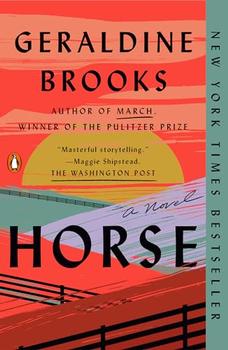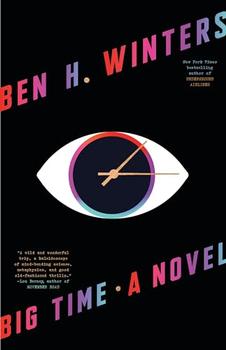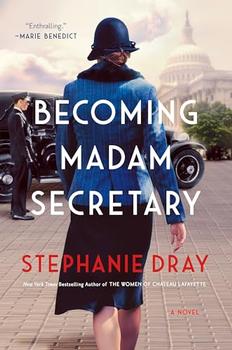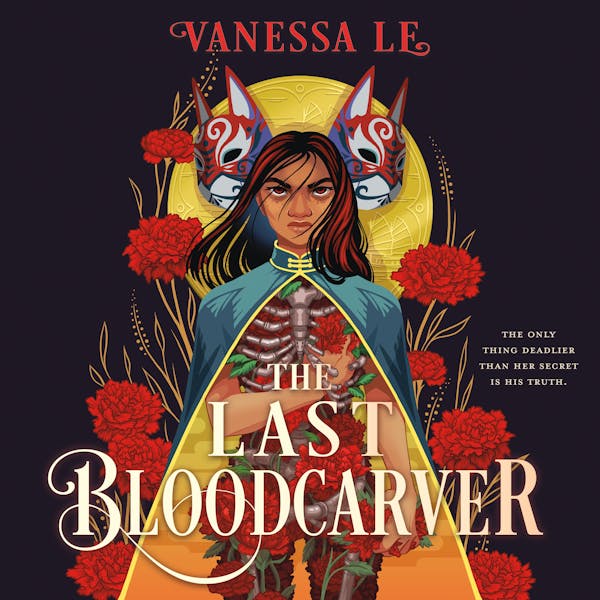Write your own review!
Shirley Larson
This book reflects the time of the Civil War and narrates three different eras regarding the famous racehorse named Lexington who ultimately sired many great racehorses up until the present time. The characters are well drawn and the story very engaging. The writer Geraldine Brooks has a way with words that makes historical fiction realistic and also entertaining. I enjoyed the book very much.
Ruth Rondberg
Great Book
I was unsure about reading a book about a horse but once I started and realized the complexity and beauty of this novel I became very sure of the book’s value.
 Cloggie Downunder
A wonderful novel that is probably her best yet.
Cloggie Downunder
A wonderful novel that is probably her best yet.
“Jarret wondered how it could be possible to have so much, just from gambling on cards and horses. If a man could win all this, then maybe he could lose it. What if he decided to wager Lexington away, or the two of them? They were his property, just like the barn.”
Horse is the sixth novel by Pulitzer prize-winning Australian author, Geraldine Brooks. In 1850, in Lexington, Kentucky, Warfield’s Jarret, son of talented Black horse trainer Harry Lewis, is present for the birth of a foal destined to become the nineteenth Century’s most remarkable racehorse and the greatest thoroughbred stud sire in racing history: Lexington.
In 1852, freelance journalist and artist, Thomas J. Scott witnesses the closeness of the pair when he is there to capture the horse in oils.
In 2019, aspiring art historian and freelance writer Theo Northam is in Washington DC working on a thesis about the representation of black people in nineteenth Century art when he stumbles on a dingy painting of a bay colt in a junk pile. He takes advantage of a Smithsonian contact to have the painting identified and evaluated at their Conservation Institute.
Australian manager of the vertebrate Osteology Prep Lab at the Smithsonian Museum Support Centre, Jess encounters Theo when she tries to find out more about the nineteenth Century equine skeleton kept for many years in a dusty museum attic, located at the request of a British researcher studying equine anatomy.
In 1954, Manhattan gallery owner Martha Jackson is offered a painting that markedly departs from the usual style of her acquisitions, but her generally quiescent sentimental bone twinges, and she adds the painting to her private collection.
How these characters are linked is the basis of an enthralling tale that serves as a tribute to horses and art, and those who love and care for both. But the reader doesn’t have to be a fan of horses or racing or art to be utterly captivated.
Told over three timelines by five main narrators, this story gives the reader a wholly credible collision of reality and imagination, interweaving fact with fiction, all of it rich in historical detail. a marvelously diverse cast of real people and fictional characters. Brooks gives them depth and appeal, wise words and insightful observations. And she does it all with some gorgeous descriptive prose.
“Jarret learned the unfamiliar names: the burnt sienna that he’d thought of as mere brown, the French ultramarine that he’d known simply as blue. But blue wasn’t so simple to Scott. He had Prussian blue, cerulean, cobalt, teal, navy. So many complicated words for a simple thing. Jarret knew the names for horse colors— bay, blood bay, buckskin, dun, roan— but now it seemed like every other thing was just as various if you troubled to look at it closely.”
“It wasn’t a good idea to speak without putting a deal of thought into it. Words could be snares. Less of them you laid out there, less likely they could trap you up.”
While the focus is on the horse and the people around him, Brooks also touches on racism in all its extremes: slavery, the shooting of unarmed black people, and the insidious everyday racism that occurs due to privilege or ignorance. The ingrained cruelty of modern-day horseracing, especially to those horses that fail to make the grade, is also touched on.
Her meticulous research into horses, art, and racism is apparent on every page and it is heartening to see that she has incorporated her late husband’s love of Civil War history into the story. A wonderful novel that is probably her best yet.
This unbiased review is from an uncorrected proof copy provided by NetGalley and Little, Brown Book Group UK.
 Cathryn Conroy
A Masterpiece! Truly Imaginative, Multilayered Story That Is a Gripping, Can't-Put-It-Down Read
Cathryn Conroy
A Masterpiece! Truly Imaginative, Multilayered Story That Is a Gripping, Can't-Put-It-Down Read
A book about a racehorse from the 1850s? Well, that doesn't interest me. But a book by Geraldine Brooks? That I cannot resist. She is one of my favorite authors, and this novel is yet again a reason why.
Quite simply, this is a masterpiece. It's a truly imaginative, multilayered story that is a gripping, can't-put-it-down read.
The book is several stories in one, but the common thread is the true story of Lexington, a powerful, legendary racehorse in the 1850s that transformed the sport. With Lexington as the centerpiece, Brooks has crafted multiple stories, each of which is riveting:
• Lexington, Kentucky, 1850: Jarrett, an enslaved young man in Kentucky, has a special talent for training horses. At a young age, he is given responsibility for Lexington, and the two develop a special bond that is never severed. One night during the Civil War, Jarrett's courage and passion are supremely tested.
• Lexington, Kentucky, 1850: Thomas J. Scott is an itinerant painter specializing in horses. His chapters are written in the first person just as he would have spoken.
• New York City, 1954: Martha Jackson is one of the very few female art dealers. Although she specializes in modern art, she comes across an oil painting of Lexington of mysterious origin.
• Washington, D.C., 2019: The unlikely pair of Jess, an Australian bone specialist with the Smithsonian who finds Lexington's preserved skeleton in a Smithsonian warehouse attic, and Theo, a Nigerian American PhD student in art history at Georgetown University who finds one of Scott's paintings of Lexington discarded in a curbside junk pile, meet and develop both a professional and personal relationship.
But this is more than a horse story. Throughout the book, Brooks deftly deals with racism—from the cruelty and inhumanity of slavery to the piercing and hurtful racial microaggressions that taunt Blacks today. How Jarrett and Theo feel and how they are treated is as important a part of the story as what they do.
The chapters bounce back and forth in time and place, but Brooks, the consummate storyteller, always has it under control so it's never confusing or disjointed. Rich historical detail, complex characters, and writing that is pitch-perfect together make this an extraordinary novel—even for those of us who know nothing about racehorses.
An aside: The dedication made me cry. Truly. So much that I couldn't turn the page right away.
sealibber
beautiful book
Not an equestrian personally but the beauty in which Brookes writes of horses and their keepers is fantastic and entrancing. She does not hesitate to go into the very uncomfortable past and present state of race and relations and the often inhumane treatment of animals and the juxtaposition of the two.
Marie Cassidy-Walker
Thoroughly recommended
"Smithsonian Museum Support Centre, Maryland 2019: Catherine stepped up to the exhibit label on the plinth and drew out her reading glasses. “Horse!” she read. “I can’t believe it! I don’t suppose you people have the Mona Lisa stashed somewhere, labelled, Smiling Girl?” She ran a finger over the terse nameplate. “Not just Horse,” she said. “The horse. What you have here is the greatest racing stallion in American turf history.” (p70)
This is the story of an enslaved groom named Jarret and the compelling relationship between him and a famous US thoroughbred racehorse called Lexington. It is a story about enslavement, racism, horse racing, art and science and the book is set in 3 different time periods: 1850, 1950, and 2019. The story lines have been thoroughly researched and I learned so much, loved it.
Renee Claudette Shambeau
The best book I have read this year!
Author's command of English is excellent. The Art and Science and Character development and the Horse himself led to very satisfying reading. I have read many books on racism and slavery and the story Brooks tells is a whole new slant on history.
Louisa
Horse
I love horses and liked this book because it gave a look into a part of history unknown to me. Amazingly researched. I thought a different format, rather than short chapters set in different years, would have made the story easier to follow. Other than that, it was wonderful .

 Book Reviewed by:
Book Reviewed by:



